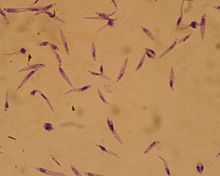Leishmania major
| Leishmania major | |
|---|---|

| |
| Promastigotes of Leishmania major, 10×100, Giemsa stain. | |
| Scientific classification | |
| Domain: | Eukaryota |
| Phylum: | Euglenozoa |
| Class: | Kinetoplastea |
| Order: | Trypanosomatida |
| Genus: | Leishmania |
| Species: | L. major
|
| Binomial name | |
| Leishmania major Yakimoff and Schokhor, 1914
| |
Leishmania major is a species of
Biology
Life cycle
As a
Hosts
Infection
Upon entering the
Enzymatics
Dimethylallyltranstransferase is vital to L. major, making it an interesting target for leishmaniacidal substances.[17] Propenko et al. 2014 present and validate several dimethylallyltranstransferase inhibitors.[17]
Epidemiology

The
L. major and its cousin, L. tropica, are recognized as causing the majority of cases of cutaneous leishmaniasis across the Middle East, Northern Africa, and some areas of China and India (as mentioned above). Between 2002 and 2004, over 700 cases of the disease were reported among United States military personnel serving in Iraq.[21]
Clinical manifestations

Upon becoming infected, patients usually present with
Diagnosis
Leishmania major should be considered in the
The most common ways of diagnosing
Treatment
Because the
- Fluconazole given in 200 mg doses over the course of 6 weeks resulted in 90% cure rate versus 60% in those given a placebo.[23]
- Topical application of 15% paromomycin and 12% methylbenzethonium has been used successfully to treat patients in Israel.[24]
- Intralesional
Prevention
The spread of
Though a
References
- PMID 11907288.
- ^ "Leishmania major". Wellcome Trust Sanger Institute, Genome Research Limited. Retrieved 6 December 2012.
- ^ PMID 24626301.
- ^ ISBN 0-7216-3411-7.
- ^ ISBN 9780443066689.
- ^ "Parasites - Leishmaniasis". Centers for Disease Control and Prevention. Retrieved November 27, 2012.
- ^ ISBN 0-911910-50-6.
- PMID 19359589.
- PMID 23935521.
- ^ a b c d Iowa State University; Institute for Cooperation in Animal Biologics; Iowa State University College of Veterinary Medicine; OIE Collaborating Centre for Diagnosis of Animal Disease and Vaccine Evaluation in the Americas; OIE Collaborating Centre for Day-One Veterinary Competencies and Continuing Education; United States Department of Agriculture (August 2017). "Leishmaniasis" (PDF).
- ^ International Office of Epizootics Biological Standards Commission (May 2021). "3.1.11 Leishmaniosis". Manual of Diagnostic Tests and Vaccines for Terrestrial Animals (mammals, birds and bees). Paris. pp. 1–13.
{{cite book}}: CS1 maint: location missing publisher (link) - ^ S2CID 12902476.
- S2CID 38584080.
- PMID 3614272.
- ^ S2CID 25927742.
- ^ S2CID 3518660.
- ^ PMID 28161253.
- PMID 1462660.
- PMID 3605504.
- ISBN 0-85199-436-9.
- PMID 15057192.
- PMID 473304.
- PMID 11907288.
- PMID 1430361.
![]() Media related to Leishmania major at Wikimedia Commons
Media related to Leishmania major at Wikimedia Commons
